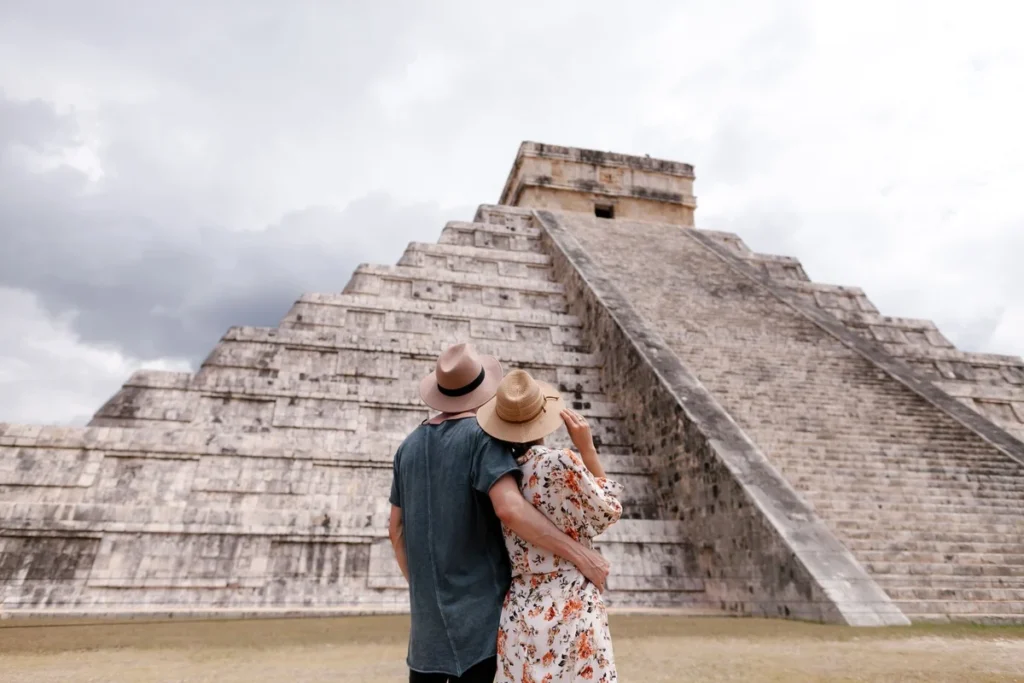Is It Safe to Visit Mexico in 2024? An In-Depth Guide

Posted on 2024-03-25
Introduction
Traveling to new destinations opens a world of experiences, but safety concerns can cloud the excitement, especially for places like Mexico. Known for its breathtaking landscapes and rich culture, Mexico is a magnet for travelers despite prevalent safety concerns.
This guide aims to provide a balanced, informed view on traveling to Mexico in 2024, addressing safety concerns with up-to-date statistics, government advisories, and traveler insights.
We’ll navigate the safety landscape of Mexico, highlighting both concerns and the measures in place to ensure tourist safety. Whether you’re attracted to Mexico City’s vibrant life or the tranquil beaches of the Riviera Maya, this guide will help you make informed decisions for a safe and enjoyable trip. Join us in exploring Mexico’s beauty, equipped with knowledge and confidence.
Understanding Safety in Mexico
When discussing safety in Mexico, it’s essential to approach the subject with a nuanced perspective that acknowledges the country’s complexity and diversity. Mexico is a vast nation, boasting a rich tapestry of cultures, landscapes, and experiences. Yet, its portrayal in the media, particularly regarding safety, can often be one-dimensional, focusing disproportionately on areas of concern.
To truly understand safety in Mexico, one must consider various factors, including geographical diversity, efforts by local and national authorities to protect tourists, and the experiences of the millions of visitors who travel to Mexico each year without incident.
Geographic Variability and Tourist-Centric Security
When discussing safety in Mexico, it’s essential to approach the subject with a nuanced perspective that acknowledges the country’s complexity and diversity. Mexico is a vast nation, boasting a rich tapestry of cultures, landscapes, and experiences. Yet, its portrayal in the media, particularly regarding safety, can often be one-dimensional, focusing disproportionately on areas of concern.
To truly understand safety in Mexico, one must consider various factors, including geographical diversity, efforts by local and national authorities to protect tourists, and the experiences of the millions of visitors who travel to Mexico each year without incident.
Geographically, Mexico is a mosaic of bustling cities, serene beaches, ancient ruins, and picturesque towns. The safety situation varies significantly across these regions. Popular tourist destinations such as Cancun, Playa del Carmen, Tulum, and Puerto Vallarta, are generally considered safe for travelers, thanks to a strong focus on tourism security and infrastructure.
These areas, known for their natural beauty and cultural significance, attract tourists worldwide and have a vested interest in maintaining a safe environment.
Conversely, there are regions, particularly certain areas along the U.S.-Mexico border and in rural parts of the country, where travel advisories caution against non-essential travel due to drug cartel activity and related violence. It’s crucial for travelers to consult current travel advisories from reliable sources such as the U.S. Department of State or the Government of Canada before planning their trip.
The Mexican government has undertaken significant measures to ensure the safety of tourists. Recognizing the importance of tourism to the country’s economy, initiatives have been implemented to enhance security in tourist areas. This includes the deployment of tourist police, who are specially trained to assist and protect international visitors, and the establishment of English-language hotlines for emergency assistance.
Furthermore, collaboration between the government and local businesses has led to the development of safety protocols in hotels, resorts, and other tourist establishments, aiming to create secure environments for visitors.
Popular Tourist Destinations and Their Safety Profile

Exploring the safety profiles of Mexico’s popular tourist destinations is crucial for any traveler wishing to visit this culturally rich and diverse country. Mexico’s appeal as a travel destination lies in its variety — from the bustling streets of its cities to the tranquil shores of its beach resorts. Each destination offers a unique experience but comes with its own set of safety considerations.
- Cancun: Known globally for its stunning Caribbean beaches, vibrant nightlife, and luxurious resorts, Cancun is a jewel in the crown of Mexico’s tourist destinations. Located in the state of Quintana Roo, it is part of the Riviera Maya, a stretch renowned for its all-inclusive resorts and archaeological wonders. Despite the occasional headlines about safety concerns, Cancun remains a relatively safe destination for tourists, especially within the Hotel Zone, where security is a top priority for businesses catering to international visitors. Travelers are advised to exercise standard precautions, such as staying within well-traveled areas and using reputable taxi services.
- Mexico City: The country’s capital, Mexico City, is a bustling metropolis rich in history, culture, and cuisine. While the city has faced challenges related to crime, areas popular with tourists like Condesa, Roma, and Polanco are considered safer and are regularly patrolled by police. The city’s government has made significant efforts to improve safety, including the installation of surveillance cameras and increased lighting in public areas. Visitors are encouraged to be mindful of their surroundings, avoid carrying large amounts of cash, and use secure transportation options, especially at night.
- Puerto Vallarta: Nestled on the Pacific Coast, Puerto Vallarta is favored for its beautiful beaches, vibrant arts scene, and friendly locals. This destination is widely regarded as safe for tourists, partly due to the strong community and emphasis on tourism safety. The city offers a diverse range of activities, from beach relaxation and water sports to exploring the historic old town. As with any tourist area, it’s wise to stay in well-lit, populated areas and follow local advice on safety.
- Tulum: Once a sleepy beach town, Tulum has emerged as a destination for those seeking a blend of relaxation, history, and eco-tourism. Famous for its Mayan ruins and crystal-clear cenotes, Tulum attracts a crowd looking for a more laid-back alternative to Cancun. While Tulum is generally safe, recent years have seen an increase in tourist-related incidents, urging travelers to be more cautious, especially at night and in secluded areas. Sticking to the main areas, using reputable tour companies for excursions, and respecting local advisories will enhance safety.
- Oaxaca: Renowned for its culinary scene, indigenous cultures, and colorful festivals, Oaxaca is a magnet for those looking to experience a deeper slice of Mexican heritage. Oaxaca’s safety profile is positive, with tourists rarely encountering issues beyond the occasional petty theft, which is preventable through vigilance and basic precautions. The city’s rich tapestry of markets, museums, and historic sites can be enjoyed safely, though it’s advisable to follow local guidance, particularly during large public events.
- For each of these destinations, the key to a safe visit lies in staying informed, being aware of one’s surroundings, and taking common-sense precautions. Travelers should check the latest travel advisories and local news, use reputable transportation services, and respect local customs and advice. By doing so, visitors can safely enjoy the diverse experiences Mexico has to offer, from its stunning beaches and historic ruins to its bustling cities and tranquil towns.
Areas to Exercise Caution

Understanding where and why to exercise caution can significantly contribute to a safer and more enjoyable visit.
Border Regions: Areas near the U.S.-Mexico border, such as Tijuana, Ciudad Juarez, and Nuevo Laredo, have been known for higher levels of drug cartel-related violence and crime. While these incidents are rarely targeted at tourists, the potential for being in the wrong place at the wrong time exists. It’s advisable to research current conditions and travel advisories if your journey requires crossing into these regions.
Certain States in Mexico: States like Guerrero (excluding the tourist city of Ixtapa-Zihuatanejo), Michoacán (except the city of Morelia), and parts of Chihuahua face challenges related to organized crime. Travelers considering visits to these areas should be especially diligent in their research, adhere to travel advisories, and, if possible, consult with local contacts or experts on the ground.
Night Travel: Traveling by road at night in remote areas of any country can introduce risks, and Mexico is no exception. Dimly lit roads, potential hazards, and reduced visibility make night travel less safe. Opting for daylight travel, especially when moving between cities or regions, is a wise precaution.
Secluded Tourist Attractions: While seeking off-the-beaten-path experiences can lead to some of the most memorable aspects of a trip, it’s important to exercise caution when visiting secluded tourist attractions. Lesser-known sites might not have the same level of security or tourist police presence as more popular destinations. Always inform someone of your itinerary, consider hiring a local guide, and research the area beforehand.
Public Transport in Large Cities: In bustling urban centers, public transportation can be a hotspot for petty theft and pickpocketing. While these risks should not deter you from using these services, being mindful of your belongings and surroundings, and avoiding overly crowded vehicles, can help mitigate risks.
Natural Hazards: Certain areas of Mexico are prone to natural hazards, such as hurricanes along the Pacific and Gulf coasts, volcanic activity near Mexico City, and seismic activity throughout the country. Staying informed about weather and natural event advisories during your visit is crucial for safety.
Exercising caution does not mean avoiding these areas altogether but approaching them with an informed perspective.
Leveraging a specialized travel service like DromoTrip can significantly enhance your safety in Mexico. DromoTrip crafts personalized itineraries with a focus on safety, collaborating with knowledgeable local agents. These agents provide up-to-date safety advice, recommend secure accommodations, and ensure safe transportation options. Their local expertise allows you to enjoy Mexico’s rich experiences worry-free. To see how DromoTrip can create a secure, customized Mexican adventure for you.
Safety Tips for Travelers
To ensure a safe and enjoyable trip, here are essential safety tips for travelers:
Stay Informed: Before and during your trip, keep up with current travel advisories and local news. Websites like the U.S. Department of State or Canada’s Travel and Tourism page offer updated travel warnings and advice.
Use Trusted Transportation: Opt for reputable transportation services, especially for long distances. Authorized taxis or ride-sharing apps are safer than hailing cabs off the street. When renting a car, use established rental agencies.
Secure Your Belongings: Petty theft can happen, especially in crowded areas. Use anti-theft bags, keep valuables out of sight, and utilize hotel safes for important documents and items.
Travel Insurance: Obtain comprehensive travel insurance that covers medical emergencies, theft, and trip cancellations. This can be a lifesaver in unexpected situations.
Health Precautions: Drink bottled or purified water, be cautious with street food, and stay updated on any vaccinations recommended by health authorities. Carrying a basic travel health kit can address minor ailments.
Stay Connected: Keep your phone charged and consider purchasing a local SIM card or international plan for easy communication. Share your travel itinerary with family or friends back home.
Learn Key Phrases: Knowing basic Spanish phrases or having a translation app can greatly aid in navigating Mexico and interacting with locals, especially in less touristy areas.
Respect Local Customs: Understanding and respecting local customs, traditions, and laws will enhance your travel experience and help avoid unintentional offenses.
Avoid Risky Areas: Stay clear of areas known for higher crime rates, especially after dark. Research your destinations beforehand and heed local advice.
Emergency Contacts: Keep a list of emergency contacts, including local emergency services (the nationwide emergency number in Mexico is 911), your country’s embassy or consulate, and local contacts if available.
Beach and Water Safety: Heed flags and warnings at beaches, never swim alone, and avoid alcohol if planning to swim or engage in water sports.
Natural Disaster Awareness: Mexico can experience natural events like hurricanes, earthquakes, and volcanic eruptions. Familiarize yourself with safety protocols for such occurrences if you’re visiting areas prone to these events.
By following these safety tips, travelers can mitigate risks and focus on the rich experiences that Mexico has to offer.
How to stay informed

For the most current travel advisories, local insights, and detailed destination guides, leveraging reputable travel websites can greatly enhance your trip planning to Mexico. Consider bookmarking these renowned sources for reliable, up-to-date information:
U.S. Department of State – Mexico Travel Advisory: Stay informed on safety, security, and entry requirements
Canada’s Travel and Tourism – Mexico Travel Advice: Access travel advice and alerts for Mexico
Lonely Planet – Mexico: Discover in-depth travel guides, tips, and inspiration for your Mexican adventure
TripAdvisor – Mexico: Read traveler reviews, find popular attractions, and book tours and accommodations
DromoTrip: Personalize your adventure with bespoke itineraries tailored by local experts. Start planning your safe and unforgettable Mexican journey
Conclusion
In conclusion, while Mexico’s vibrant culture, stunning landscapes, and rich history make it an enticing destination for travelers worldwide, safety remains a paramount concern. By understanding the safety landscape, recognizing areas to exercise caution, and adhering to key safety tips, travelers can significantly mitigate risks and focus on the enriching experiences Mexico has to offer. Leveraging reputable travel resources, including DromoTrip, and staying informed through trusted websites, ensures that you are well-prepared for your journey.
Remember, the vast majority of trips to Mexico are completed without incident, and with the right precautions, your visit can be a safe, enjoyable, and unforgettable adventure. Embrace the beauty and diversity of Mexico with an informed and respectful approach, and you’re set for an incredible travel experience.
One more thing..
Ready to embark on your unforgettable journey to Mexico, armed with the best safety tips and expert advice? Begin your adventure by exploring our carefully curated resources and personalized travel planning services. Don’t let the planning process overwhelm you; let DromoTrip guide you through creating a trip that’s not only memorable but also safe. Dive into the vibrant culture, breathtaking landscapes, and rich history of Mexico with confidence.
Click here to start planning your dream Mexican getaway with DromoTrip. Your adventure awaits—secure, informed, and tailored just for you. Vamos a México!